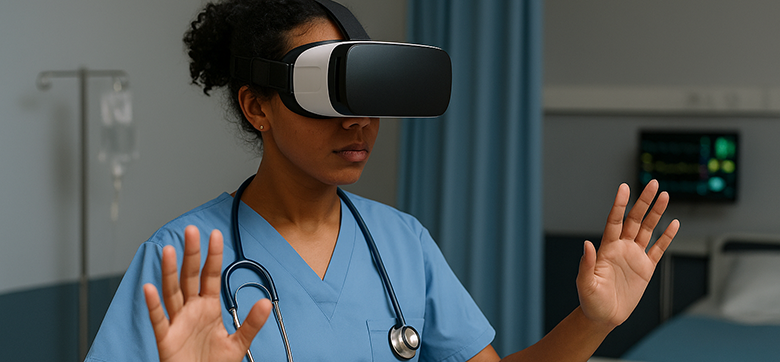Healthcare has embraced simulation as a cornerstone of clinical education, using realistic scenarios to build critical thinking, procedural skills, and team coordination for situations ranging from cardiac arrests to surgical complications. Yet surprisingly few organizations apply these same powerful simulation methodologies to workplace violence prevention. Those that do are discovering that simulation-based conflict training offers unique advantages that traditional classroom approaches simply cannot match.
The Simulation Advantage for Conflict Management
Simulation creates distinct benefits for conflict management skill development:
Psychological fidelity: Recreates the emotional responses that often interfere with skill application during actual conflicts
Consequence-free practice: Allows mistakes and experimentation without risk to patients or staff
Real-time feedback: Provides immediate input on technique effectiveness
Team coordination development: Builds collective capabilities rather than just individual skills
Scenario customization: Creates practice opportunities specific to your organization's unique challenges
These advantages address the critical gap between theoretical knowledge and practical application that plagues many conflict management programs.
Effective Simulation Modalities
Various simulation approaches offer different benefits for conflict training:
Standardized participants: Trained actors who consistently portray specific behaviors allow for reliable skill practice and assessment
Virtual reality simulation: Immersive environments that create psychological realism while allowing unlimited repetition
Video-based scenarios: Recorded situations that prompt decision-making and discussion
Role-play with moulage: Enhanced realism through physical props, makeup, and environmental elements
Hybrid simulations: Combinations of approaches that address different learning objectives
The most effective programs utilize multiple modalities to build comprehensive capabilities.
The Vistelar Methodology in Simulation
Vistelar's conflict management framework translates exceptionally well to simulation through:
Scenario-based training design: Real-world situations that allow practice of specific techniques in context
Progressive complexity: Scenarios that build from basic interactions to challenging situations
Structured feedback processes: Specific guidance on technique application and effectiveness
Team coordination emphasis: Practice applying unified approaches across different roles
Unified terminology: Consistent language that enhances communication during simulations
This methodology creates a natural foundation for effective simulation-based learning.
development activities.
Implementing Simulation-Based Conflict Training
Successful implementation requires thoughtful design:
Phase 1: Foundation Building
- Define specific learning objectives for simulation activities
- Develop scenarios based on actual organizational incidents
- Train simulation facilitators in both conflict management and simulation methodology
- Create assessment tools for evaluating performance
- Establish psychological safety guidelines for participants
Phase 2: Initial Implementation
- Begin with low-complexity scenarios focusing on fundamental skills
- Provide structured debriefing following each simulation
- Create progressive challenges as skills develop
- Incorporate interdisciplinary participation reflecting actual team composition
- Gather participant feedback for continuous improvement
Phase 3: Advanced Applications
- Implement in-situ simulations in actual work environments
- Create unannounced drills to test readiness
- Develop team-based scenarios addressing complex situations
- Incorporate leadership roles reflecting organizational hierarchy
- Connect simulation performance to clinical outcomes
This phased approach builds capabilities while maintaining psychological safety for participants.
Simulation Design Elements That Enhance Learning
Certain design features significantly impact simulation effectiveness:
Pre-briefing: Establishing psychological safety and learning objectives before scenarios begin
Appropriate challenge level: Creating situations difficult enough to promote learning without overwhelming participants
Structured debriefing: Using consistent frameworks to review performance and identify improvement opportunities
Video review: Recording simulations for detailed analysis and self-assessment
Peer feedback: Incorporating multiple perspectives on performance
Deliberate practice: Focusing on specific skills with repetition and progressive refinement
Distributed learning: Spacing simulation sessions over time rather than massing practice in single events
These elements transform simulation from an interesting experience into powerful learning.
Technology Enhancements for Conflict Simulation
Emerging technologies are expanding simulation possibilities:
Virtual reality environments that create immersive, reproducible scenarios
AI-driven avatar interaction allowing unlimited practice with responsive virtual participants
Biometric monitoring providing objective data on stress responses during simulations
Mobile simulation platforms enabling practice in diverse settings
Mixed reality applications blending virtual elements with physical environments
These technologies can enhance learning while reducing resource requirements for large-scale implementation.
Measuring Simulation Effectiveness
To demonstrate value and guide improvement, implement:
Pre/post skill assessments measuring specific conflict management competencies
Transfer evaluation examining application in actual work settings
Participant confidence surveys assessing perceived preparedness for real situations
Incident rate comparison between simulation-trained and traditionally trained staff
Return on investment analysis considering both implementation costs and outcome benefits
These measurement approaches create accountability while providing compelling evidence for continued investment.
Healthcare organizations that apply the same rigorous simulation methodologies to conflict management that they use for clinical skills discover a powerful approach for building genuine capability rather than theoretical knowledge. By creating psychologically realistic scenarios that allow consequence-free practice of the entire conflict management spectrum, simulation bridges the critical gap between knowing what to do and being able to do it effectively when it matters most. The result is not just enhanced learning but genuine readiness for the complex interpersonal challenges healthcare professionals face daily.








